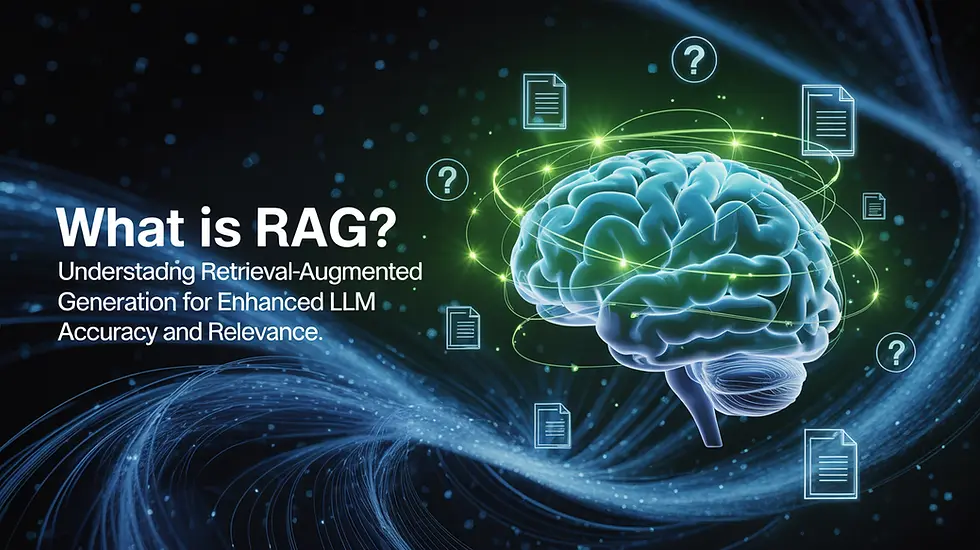What is RAG? Understanding Retrieval-Augmented Generation for Enhanced LLM Accuracy and Relevance
- Gareth Moore
- Aug 4
- 4 min read
Large Language Models (LLMs) have revolutionized how we interact with information, but they have a hidden limitation: their knowledge is static and limited to their training data. Imagine an LLM trying to answer a question about the latest company policy or a newly released product. Without being specifically trained on that up-to-the-minute information, it might struggle or even "hallucinate" (make up facts). This is where Retrieval-Augmented Generation (RAG) comes in, offering a powerful solution to extend an LLM's capabilities.

What is RAG?
Retrieval-Augmented Generation (RAG) is a powerful natural language processing (NLP) architecture that combines document retrieval with text generation. Instead of relying only on its internal knowledge, a RAG pipeline enables an LLM to query external sources (like databases, document stores, or websites) and use that retrieved information to generate grounded, context-aware responses.
This approach ensures that answers are not just fluent, but also factually accurate and up to date, making RAG ideal for real-world applications such as:
AI chatbots and virtual assistants
Customer support tools
Knowledge management systems
Legal, healthcare, and academic research assistants
Enterprise search applications
Why is RAG a Game-Changer?
Traditional LLMs are powerful but limited. They can’t natively access new information that arises after their last training cut-off. This makes them unreliable for:
Answering time-sensitive or domain-specific questions
Providing real-time support
Handling personalized business use cases
RAG solves this problem by enabling dynamic, on-demand retrieval from trusted knowledge sources, including:
Internal company documentation
Product catalogs and databases
Wikis and knowledge bases
Scientific and academic publications
News and financial data feeds
By retrieving relevant context at runtime, RAG dramatically reduces hallucinations, improves factual grounding, and increases trust in AI-generated content.
How a RAG Pipeline Works: A Step-by-Step Breakdown
The power of RAG lies in its structured pipeline, typically involving three core steps:
1. Retrieval Step
When a user submits a query, the system first searches an external knowledge base to find relevant information. This could involve a semantic search over:
A vector store (e.g., FAISS, Pinecone)
A document database (e.g., Elasticsearch)
A website or API
Unlike simple keyword search, RAG typically uses embedding-based retrieval (semantic search) to match concepts, not just terms.
2. Augmentation Step
The retrieved information, often the top N passages or documents, is then added as context to the original query. This augmented input gives the LLM real-time grounding so that it can reason over accurate, up-to-date information.
3. Generation Step
Finally, the LLM takes the augmented input and generates a fluent, contextually grounded response. The result is an answer that’s not just coherent, it’s factually supported by relevant external data.
Real-World Example: Answering Medical Queries
User query: “What are the side effects of Drug X?”
Here’s how a RAG pipeline would handle it:
Retrieval: The system retrieves medical documents about Drug X from a pharmaceutical database, Mayo Clinic, or FDA data feed.
Augmentation: These passages are added to the user’s question and passed to the LLM.
Generation: The LLM generates a response such as:“Common side effects of Drug X include nausea, dizziness, and dry mouth, according to Mayo Clinic documentation.”
This process ensures accuracy, verifiability, and domain-specific relevance.
Key Components of a RAG Pipeline
To build a functional and scalable RAG system, you’ll typically need the following components:
Vector Store
Stores text embeddings (numeric representations of text) and supports fast semantic search.
Popular tools: FAISS, Pinecone, Weaviate, Qdrant
Embedding Model
Converts text into embeddings for both the documents and the query.
Popular choices: OpenAI embeddings (e.g., text-embedding-3-small), Cohere, Hugging Face models (e.g., all-MiniLM-L6-v2)
LLM (Language Model)
Generates responses based on the user’s query and the retrieved context.
Popular LLMs: GPT-4, Claude, LLaMA, Mistral
Orchestration Framework
Connects the retrieval, augmentation, and generation steps into a smooth pipeline.
Top frameworks: LangChain, LlamaIndex, Haystack, Semantic Kernel
RAG vs. Fine-Tuning: What’s the Difference?
Both RAG and fine-tuning aim to improve the performance of LLMs, but they take very different approaches:
Feature | RAG | Fine-Tuning |
Knowledge | Dynamic & external | Static & embedded |
Cost | Lower (no re-training required) | Higher (training and infrastructure costs) |
Flexibility | High (context can be updated anytime) | Low (requires retraining for new data) |
Accuracy | Depends on retrieval quality | Depends on training data quality |
Use Cases | Real-time queries, fast-changing info | Task-specific customization |
Bottom line:
Use RAG when you need fresh, contextual responses from up-to-date knowledge. Use fine-tuning when you want a model to behave a certain way or follow specific domain logic across all prompts.
Common Use Cases for Retrieval-Augmented Generation
Enterprise Chatbots: Empower chatbots with access to internal docs, FAQs, and SOPs
Legal Assistants: Retrieve relevant case law or regulations for grounded legal insights
Healthcare AI: Answer patient queries using verified, up-to-date medical literature
E-commerce: Power product recommendation engines or customer service assistants
Education & Research: Provide reliable, citation-backed academic assistance
Final Thoughts: RAG Is the Future of Knowledge-Aware AI
As AI adoption accelerates across industries, the demand for truthful, context-rich, and domain-specific responses is higher than ever. Retrieval-Augmented Generation offers a scalable and flexible way to meet this need, unlocking the full potential of LLMs without the limits of static training data.
Whether you’re building a smart assistant, support bot, internal knowledge tool, or custom AI product, RAG is the modern standard for dynamic, grounded AI.
Want to implement RAG for your business or application?
Explore tools like LangChain, Pinecone, and OpenAI embeddings to get started, or connect with an AI consultant to help architect your ideal RAG stack.


